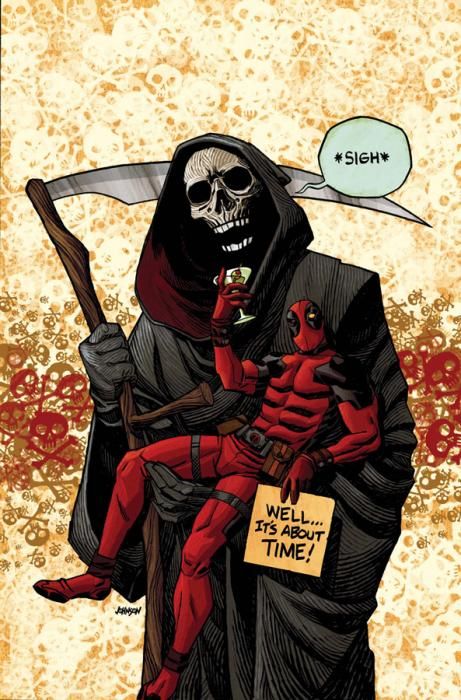Three issues into the "Dead" storyline, "Deadpool" #52 continues to tell the tale of Wade Wilson's needlessly complicated plan to finally find a way to die. Happily, the novelty of that hilarious premise has yet to wear off. Culminating in a climactic showdown between the four different forces Deadpool has been manipulating to this point, issue #52 doesn't even bother to catch the reader up on the events to date, which heightens the characteristic insanity of the book. Writing idiosyncrasies that would be weaknesses in any other title are played as strengths here by Daniel Way, as the ridiculous chess game orchestrated by Deadpool adds humor and levity to a story essentially about suicide. Rather than thinking about Wade's ultimate goal, the slapstick style of the action and combat in "Deadpool" #52 keeps you laughing and guessing at a plan we aren't certain Wade has even worked out for himself (after all, he doesn't know how to play chess).
The most pleasant surprise new readers will find proffered in "Deadpool" #52 is the stylized, energetic artwork of Ale Garza, Sean Parsons and Dommo Sanchez Amara. Garza's pencils are reminiscent of Joe Madrueira's line work in the 1990's, managing to use exaggeration to promote a sense of movement and fluidity from panel to panel. On many pages, Garza will forego producing a background, choosing to focus only on the stance or emotion of the character in any given panel; while this could detract from other books, again here it further emphasizes the rapid, uncontrolled shifts of attention from the title character, giving us no choice but to be swept into Deadpool's scattered perspective. The anime-styled swooping backgrounds provide Amara the opportunity to color an entire page in accordance with the theme of the action taking place in the panels. At the shocking close of the book, Way pays off a major plot point and the sparse, colored panels allow all of the reader's attention to be focused on the reactive expressions of the characters. Overall, the art in "Deadpool" #52 is a fine example of how less can truly be more.
Most importantly, there is a real sense of fun in every page of the issue. Beyond the jokes and surprises of the plot itself, there is a palpable sense that the creative team are having a blast working on this storyline with a strong sense of their target audience. Way's willingness to play with Wade's inner voices reaches a whole new register at the climax of "Deadpool" #52, where Psylocke appears to have heard something only offered to us in a narrative-box rather than a word-balloon. Rather than coming across as an error, we are left just as unsure as Wade himself of what he is saying, what he is thinking and whether or not he is as in control as he seems to think he is.
Perhaps the only drawback to the issue is the alienation of readers due to Way's willingness in embracing the madcap insanity of the character. It's possible those who aren't as willing to play along with the joke could receive issue #52 as a cluttered, chaotic cluster of panels. Still, even those readers who are less willing to play along will find enough laughs in the issue and enough enjoyment in the artwork to make it worth the cover price. If you're curious about the strange and unique narrative experience of both loving a character and hoping they manage to kill themselves at the same time, "Deadpool" #52 is worth checking out.

